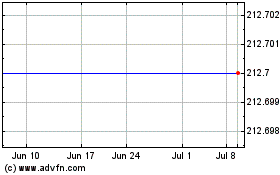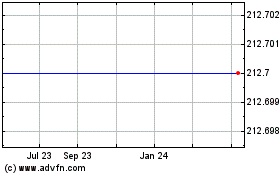UnitedHealth Issues Notes - Analyst Blog
October 11 2011 - 7:40AM
Zacks
Earlier this week, UnitedHealth Group Inc.
(UNH), the biggest insurer in the U.S., sold $750 million of
long-term notes in two tranches.
The first tranche consists of $400 million of 10-year notes,
yielding a return of 115 basis points above the similar featured
treasury securities. The other consists of $350 million with a
30-year maturity, which will yield a return of 130 basis points
above the similar featured treasury securities.
The interest spread between the treasury securities and the
company’s corporate debt indicates uncertainty prevailing in
UnitedHealth because of the health care reform and its
implications.
The proceeds flowing out of the issuance will be used for
general corporate purposes including share buyback, funding
acquisitions, repaying debt or financing working capital
requirements.
UnitedHealth’s balance sheet has a long-term debt to equity
ratio of 0.335, implying that for every dollar of long-term debt,
there is about $3.0 of equity on the
balance sheet.
Minnesotabased UnitedHealth stands healthy from a balance sheet
perspective. The company has reduced its debt-to-capital ratio to
30.1% as of December 31, 2010, down from 32.1% at 2009 end, thus
giving itself substantial future flexibility. For the past five
years, its debt ratio stands at an average of 32.1%.
UnitedHealth, which employs 87,000 individuals, ended 2010 with
a fixed charge coverage ratio of 14.0X. It implies that the company
earns enough before taxes to cover its interest payments 14 fold,
thus providing a strong coverage.
We also note that UnitedHealth has long term debt-to-cash ratio
of 0.8:1 (as of December 31, 2010, United had $8,662 million in
long-term debt outstanding and their cash and short term investment
accounts held $11,195.0 million in assets). This indicates that
with short-term assets at current levels, it can absorb earnings
hit, if any, and survive.
The notes have “bbb+” rating along with a stable outlook from
the rating agency, A.M.Best. The “bbb+” rating reflects investment
grade status with a good credit quality, and the stable outlook
implies lower possibility of a rating change due to stable
financial/markets trends.
As of December 31, 2010, UnitedHealth’s senior unsecured debt
was rated Baa1 with a stable outlook and A- with a negative outlook
by Standard & Poor’s and Fitch, respectively.
Prior to this issuance, UnitedHealth, the biggest U.S. health
insurer by revenue, came out with $750 million of long-term notes
in two tranches in October 2010, which had been the first bond
offering since February 2008, when it raised $3.0 billion through
senior unsecured notes.
UnitedHealth continues to be disciplined in its capital
allocation this year (2011). It has historically returned a
substantial portion of its net earnings to shareholders through
share repurchase and dividends, which have averaged more than 80%
of the net income over the past five years.
UnitedHealth competes with other players in the health insurance
sector, such as WellPoint Inc. (WLP),
CIGNA Corp. (CI), Aetna Inc.
(AET), Humana Inc. (HUM), etc.
AETNA INC-NEW (AET): Free Stock Analysis Report
CIGNA CORP (CI): Free Stock Analysis Report
HUMANA INC NEW (HUM): Free Stock Analysis Report
UNITEDHEALTH GP (UNH): Free Stock Analysis Report
WELLPOINT INC (WLP): Free Stock Analysis Report
Zacks Investment Research
Aetna (NYSE:AET)
Historical Stock Chart
From Apr 2024 to May 2024

Aetna (NYSE:AET)
Historical Stock Chart
From May 2023 to May 2024
